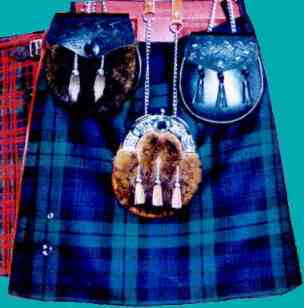| A Modern | Feilidhmhor |
provided by Mitchell Kilt Hire and Wedding Pipers (go to main hire information page)
Kilts are menswear! They can be Scottish, Irish, Welsh (cilts) and Cornish. When I first started playing in Pipe Bands some older blokes would walk out rather than stay if a woman joined. One of the reasons: Men wore kilts NOT women, and if women wanted to play the pipes - let them join a "Ladies Pipe band". Attitudes have long since changed. Some women are extremely good pipers. But what about the wearing of a kilt by women when not playing in a band? Remember the days when jeans were only menswear too? Perhaps it would be easier to say women love wearing menswear and nothing is going to stop them wearing what they want these days! Apart from lady pipers and highland dancers, women do not usually wear kilts - they wear kilted skirts. There is a big difference starting with the amount of fabric used, that a pattern can be bought for a womans pleated/kilted skirt, and a whole lot of other things in the actual making/construction/sewing of the garment.
NB. Traditionally, sporrans are NOT worn by women other than when in a pipe-band.
There are a whole lot of other possible comments about the wearing of kilts however let's get back to more relevant details....
Kilts made from a symetrical repeating tartan are normally pleated to the sett. When pleating asymetric tartans (non-repeating) these would have approximations of the sett or other procedures are taken. The military style of pleating to a stripe is used because most military tartans are based on the Government or Black watch tartan (a Campbell tartan). This tartan has a very wide repeat and would otherwise require double the fabric (twice the weight). Like other non-repeating tartans compromises are made. You can have a kilt pleated to the pattern anyway you want, though there are preferred options. Various pattern effects can make the rear view dramatically different. Knife pleating is the more usual. Box pleating is sometimes used. Pleats may be 1-2.5cm in size when a full 8 yard kilt is made. If the customer requires a less expensive kilt, pleating width can go to 2.5 - 3cm. Wider pleats sacrifice the "swing of the kilt" effect and produce a stiffer style of kilt.
| A Modern | Feilidhmhor |
The original Feilidh Mhor or great kilt did not have precise pleating like the modern feilidh beag or small kilt. Feilidh is the term for the garment and Mhor means big/great; Beag means small. The Feilidh Mhor in a modern form is making a come back thanks to the films "Brave Heart" and "Rob Roy". Simple versions of kilts were worn by troops (regulars, fencibles and bush rangers) in early 19th century New Zealand. Many early settlers were highlanders and they often wore kilts.
If your waist is under 31" you can get away with around 7 yards (6.5m) of tartan or less. From 32 -39" waist you need 8 yards (7.3m) and over 40" you need 9 yards (8-8.5m) of fabric. Depending on your height the depth of the fabric to the selvedge will be somewhere between 21" and 26". Single width kilting fabric is 28" wide though most tartans are now available in double width fabric. This can be cut lengthwise down the middle, and the two pieces can then be carefully sewn end to end (ensuring the proper tartan sett) to attain the required length of fabric. Children can have kilts made from 3 yards/metres of double width tartan.
Proper kilting fabric is best for a kilt. It has a true selvedge used for the bottom edge of the kilt so there is no need for a folded hem to stop fraying. Adult kilts should not normally have a sewn hem. For practical reasons, kilts for growing children will have sewn hems that can be let down as they grow taller.
There is a lot of hype and some snobbish dictates about how, when and where kilts can be worn, and who by. The fact is, anyone can wear a kilt, anywhere, at anytime, in any way. As horribly or as magnificently as they feel. It is simply an article of clothing, generally expensive (at least when new, and when in good condition), durable, and fashionable for all times and places. It was worn by poor highlanders with hardly a thread to their name, and by wealthy landed gentry or aristocracy. To-day times are different, but there is still the option to wear a kilt as you can afford it and in accordance with normal dress sensibility suitable for the occasion.
There are tartans for the Scots, the Irish, the Cornish, the Welsh and the English! Naturally kilts can be made from all of these. Kilts can also be made from plain kilting fabrics and Irish kilts quite commonly use plain colours.

This page is on a web-site with more information
about kilts, sizing and measuring, tartans and more.
Do browse around....
| Copyright © 2002 Mitchell Kilt Hire |
Main MKH Page | Top | Contact Us | To Kilts Page | Other Links |